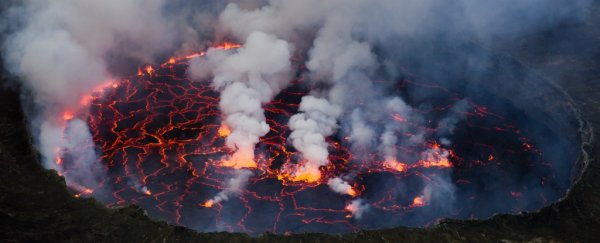Indonesian volcano Toba produced a cataclysmic eruption that devastated the region 73,000 years ago. Monstrous volcanoes like this are called supervolcanoes, and sometimes their impacts are so huge, they can cause global climate change.
Now, scientists may have worked out what triggers them to blow in a new study published in the journal Scientific Reports.
The Toba eruption was the largest volcanic eruption witnessed in history, which covered 2,800 cubic kilometres of the surrounding area in volcanic ash, causing enormous amounts of rain in Indonesia and India.
How exactly these huge amounts of magma are created (and why they erupt so violently) has been a cause of debate between scientists for a long time.
It has been known that volcanoes erupt because of density and pressure, and generally it is a way that Earth can release excess heat and pressure. Still, the precise trigger has remained a mystery.
A group of researchers at Uppsala University and their international colleagues may have found some answers lying in millimetre-sized crystals called quartz crystals embedded in the volcanic ash and rock.
Quartz crystals grow in magma, and register chemical and thermodynamical changes before an eruption, which is similar to how tree rings record climate change, according to David Budd, lead author of the study from Uppsala University.
"When the conditions in the magma change, the crystals respond and produce distinct growth zones that record these changes," he said in a statement.
"The problem is that each 'tree ring'-analogue is only a few micrometres across, which is why they are extremely challenging to analyse in detail."
While studying the quartz from Toba, the researchers found that there was a difference in the composition and weight of the outer part of the crystals compared to the inside.
Around the outside the crystals were heavier and contained a form of oxygen called 18O. On the inside, however, there was a lighter form called 16O.
According to the study authors, the ratio suggests that something in the magmatic system had changed drastically just before the big eruption.
So what happened? The researchers think that when the magma melted, it took along with it a large volume of a nearby rock which contained the same ratio.
"This rock type also often contains a lot of water, which may be released into the magma, producing steam, and thereby an increased gas pressure inside the magma chamber," said Frances Deegan, another author of the study.
"This rapidly increased gas pressure and eventually allowed the magma to rupture the overlying crust, and send thousands of cubic kilometres of magma into the atmosphere."
How often do supervolcanoes erupt?
Luckily, supervolcanoes like these erupt very infrequently. Volcanic eruptions are measured by the Volcanic Explosivity Index (VEI,) with VEI 7 and VEI 8 eruptions being the most powerful.
Other than Toba, these are some of the most massive supervolcano eruptions in history:
- La Garita Caldera erupted approximately 27.8 million years ago, and released 5,000 cubic kilometres of magma.
- Huckleberry Ridge in Yellowstone had a bulk ejection of 2,500 cubic kilometres about 2.1 million years ago.
- Atana Ignimbrite in Chile erupted about 4 million years ago, also ejecting 2,500 cubic kilometres.
- In 1815, the Tambora volcano on Sumbawa Island in Indonesia erupted in what is considered the largest ever eruption in recorded history. It was a VEI 7 on the VEI scale, but an estimated 100,000 people died from the effects, and it caused a global volcanic winter.
- Although famous, eruptions such as Mount Vesuvius (Pompeii in 79 AD) and Mount St. Helens in 1980 were very small in comparison to these supervolcanic ones.
Researchers say that Toga's eruption in particular was so colossal it came close to wiping out humanity entirely.
It's a matter of when, not if, supervolcanoes erupt again.
Here's to hoping that we're better prepared when the next one happens!
This article was originally published by Business Insider.
